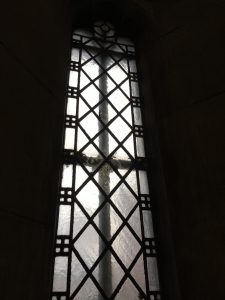Den engelska prästen och poeten John Donne (1572–1631) skrev i början av 1600-talet en dikt om Kristi uppståndelse (”Resurrection, imperfect”). I den dikten ville han beskriva och förklara uppståndelsen på tre olika sätt, från tre olika synvinklar.
I den första delen av dikten, de första åtta raderna, jämför Donne Kristus med solen. Men när Kristus uppstår är solen och alla andra ljus överflödiga, allt världsligt ljus bleknar. Det här är en välkänd bild. I den andra delen av dikten, de följande åtta raderna, presenteras Kristus som de vises sten, som lades i graven men uppstod för att kunna förvandla allt det orena och oädla till heligt och rent. På Donnes tid var användningen av denna alkemistiska språkbild även starkare än idag, eftersom man trodde att det bortom människans dåtida kunskap och förstånd verkligen kunde finnas ett något så magiskt ämne. I den tredje och sista delen av dikten använder John Donne inte längre en språkbild, utan han försöker sig på att beskriva konkret själva händelsen. Han börjar beskriva vad man kunde ha sett om någon hade vittnat uppståndelsen.
Men denna sista del av dikten innefattar bara sex rader och slutar två rader före den poetiskt sett borde, och dikten förblir således ofullbordad. (Senare förläggare har tillagt orden Desunt Cætera, ”resten fattas”, efter dikten.) Än idag, fyrahundra år senare, tvistar litteraturvetare om hur det riktigt gick till: Visst borde en poet som John Donne ha hittat de sista rimmen för att slutföra dikten? Varför klarade han inte av att beskriva konkret det han förklarat bildligt just innan?
Eller ville John Donne kanske genom att lämna dikten oavslutad visa att det här alltid förblir ett mysterium för människan: att människan inte kan förstå och därför inte kan med ord beskriva det under som uppståndelsen innebär? För Donne var det här ett mycket större under än en sol som får alla världens ljus att blekna eller de vises sten som förvandlar oädla metaller till guld. Det tomrum som dessa saknade rader skapar visar för Donne på det hisnande avståndet mellan mänsklig strävan och gudomlig fullkomlighet som han själv kämpade med hela sitt liv. Kanske svaret på mysteriet för Donne ligger i de här två diktraderna som inte finns.

(En tidigare version av den här texten har publicerats i Matteusbilagan i Kyrkpressen (nr. 13/2010). Texten publiceras här med tillstånd av chefredaktör May Wikström.)

